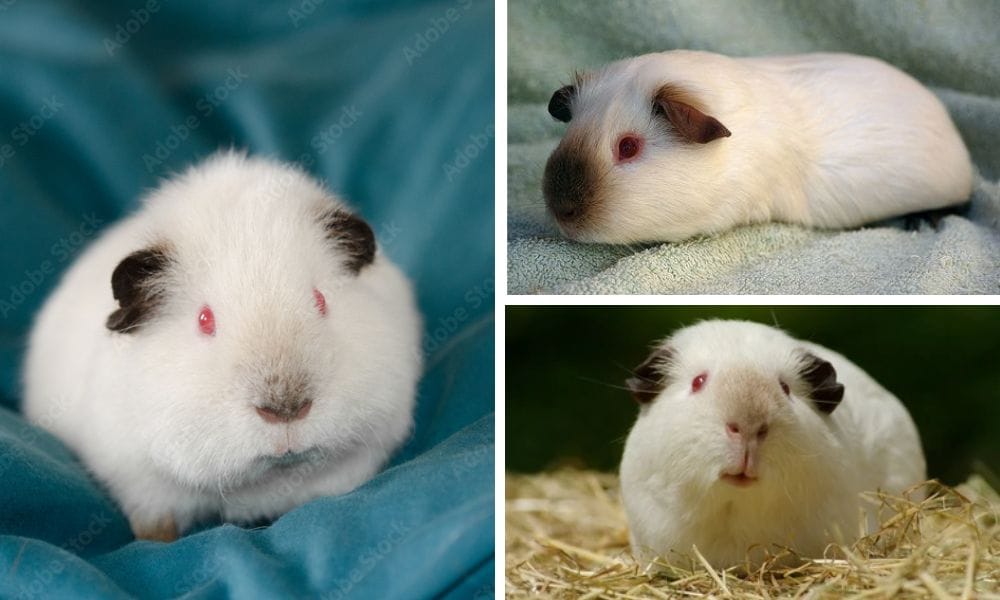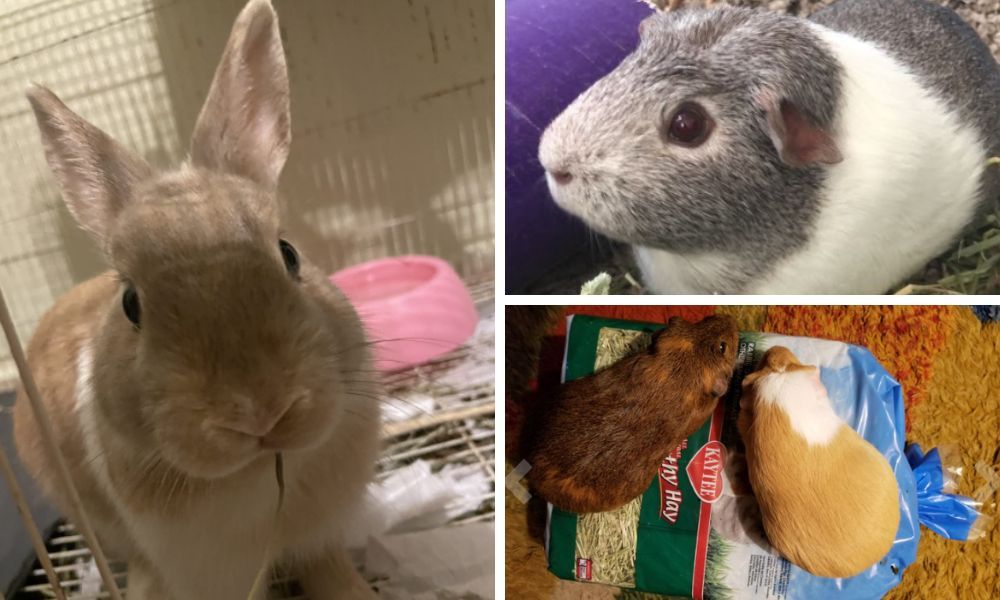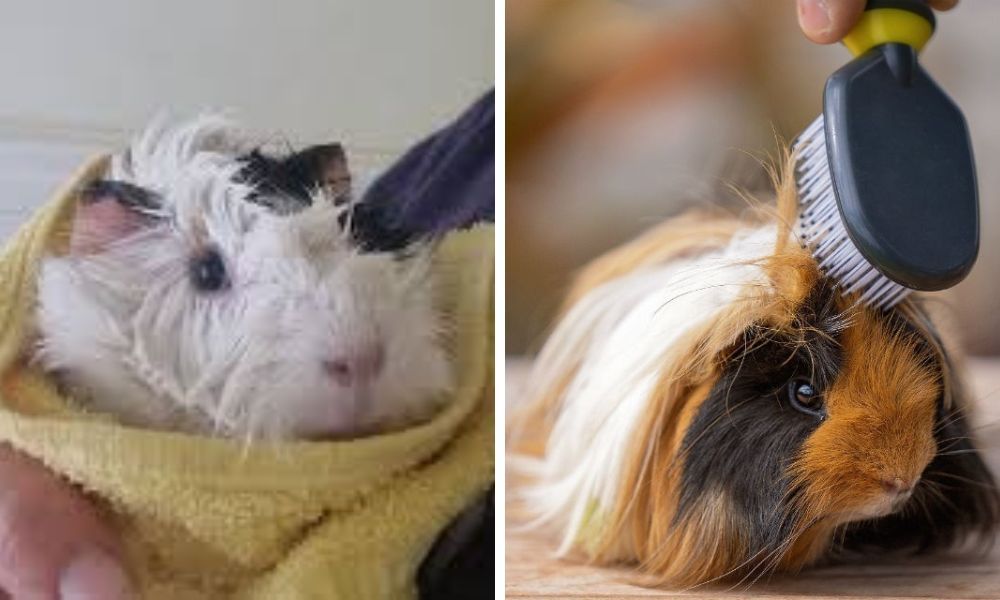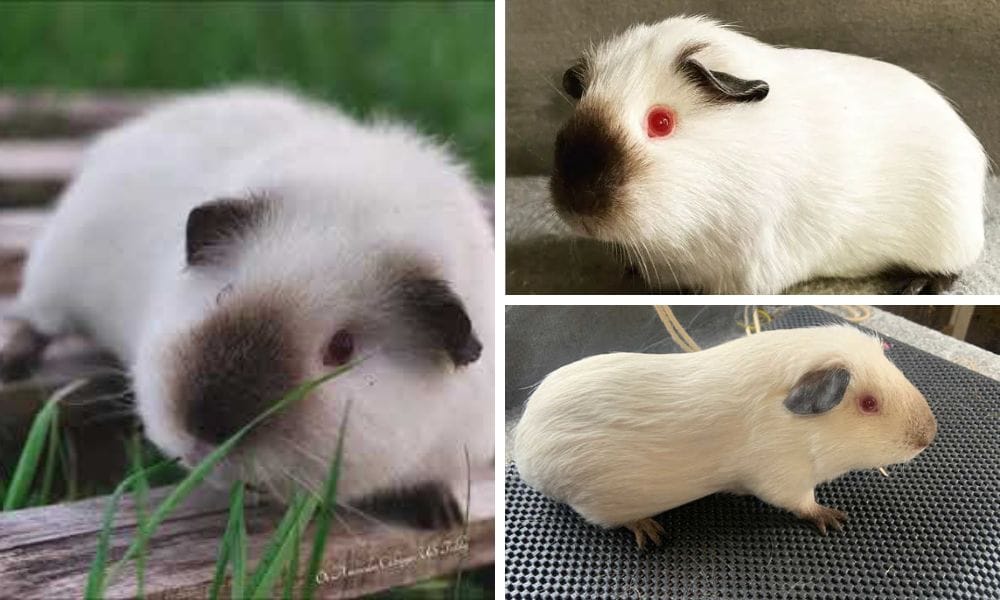The Enchanting World of Himalayan Guinea Pig
Hang on tight and get ready for an adventure into the wild world of Himalayan guinea pig! If you ever wanted to know what life is like for these adorable, furry creatures, then this blog is for you.

Key Takeaways:
- Understand the unique characteristics and care requirements of Himalayan guinea pigs, also called "the Siamese cat of the guinea pig world" due to their striking color points.
- Discover the social and affectionate nature of these small animals.
- Learn how to maintain the health and happiness of your Himalayan guinea pig through proper diet and environment.
Guinea pigs, also known as cavies, have long been cherished as delightful companions for pet lovers around the world. Among the various cavy breeds, the Himalayan guinea pig stands out with its distinctive appearance and endearing personality. Originating from South America, these small animals have captured the hearts of many with their gentle temperament and affectionate nature.
What Sets Himalayan Guinea Pigs Apart?
Himalayan guinea pigs, often compared to Siamese cats due to their similar coat color patterns, are born pure white with the potential to develop darker color points as they mature. These dark points, typically a rich milk chocolate or jet black hue, appear on their ears, nose, feet, and hind end. The contrast between their white fur and dark spots gives them a particularly cute and charming appearance, especially when paired with their bright red eyes. Like other guinea pig breeds, Himalayan guinea pigs do not have tails, which adds to their distinctive and adorable, tail-less look.
The Social Life of Himalayan Guinea Pigs
As social animals, Himalayan guinea pigs—often affectionately called piggies—thrive on interaction with other guinea pigs and humans. They are not aggressive animals and often enjoy the company of other breeds of guinea pigs. To ensure their well-being, it’s important to house Himalayan guinea pigs with compatible companions in a spacious, clean environment that allows for socialization and reduces stress. Providing them with companionship is essential for their mental health and overall well-being.
Understanding Their Care Needs
Himalayan guinea pigs require a specific environment and attentive care to maintain their coat color and overall health. They should be kept away from direct sunlight, as they can easily overheat and their coat can fade. Their living space should be spacious and equipped with proper bedding, a water bottle, and plenty of hiding spots. It is important to keep them away from cold drafts or cold temperatures, as exposure to cold can negatively affect their health.
The Importance of Diet
A balanced diet is crucial for Himalayan guinea pigs. Fresh hay, such as timothy hay, should be readily available as it aids in digestion and dental health. Himalayan guinea pigs' teeth grow continuously, so a proper diet with plenty of hay is necessary to help wear down their teeth and prevent overgrowth. Fresh vegetables and a small amount of fresh fruits rich in Vitamin C are also essential, as guinea pigs cannot produce this vitamin on their own.

Health and Grooming
Regular grooming is necessary to keep their coat clean and free of mats. Bathing them in lukewarm water can be done occasionally, but it’s important not to overdo it as it can strip their skin of natural oils. After bathing, be sure not to expose your Himalayan guinea pig to cold temperatures, as this can cause them to become chilled and lead to health issues. Regular healthcare is essential, including scheduling visits with a veterinarian for routine check-ups and dental care to ensure your guinea pig stays healthy.
The Unique Appearance of Himalayan Guinea Pigs Himalayan guinea pigs are often likened to the Siamese cat of the guinea pig world due to their distinctive coloration. Much like the Siamese cat, these guinea pigs have a creamy white base coat with darker points on their ears, nose, and feet. This color pattern is known as “Himalayan,” and it’s what makes them stand out in the cavalcade of guinea pig breeds. Their red eyes, often a subject of fascination, add to their exotic charm and are a result of a gene that causes albinism, which is also responsible for their unique coat coloration.
Unlike the Peruvian guinea pigs with their long, flowing locks, or the rosette-covered coat of Abyssinian guinea pigs, Himalayan guinea pigs boast a short hair coat that is easier to maintain. Some breeds, like the Teddy guinea pig, have harsh or fuzzy fur, giving them a teddy bear-like appearance, while others have plush coats. This makes them a great pet for individuals or families who may not have the time for the extensive grooming that other breeds require. Their short hair also highlights their color points, making the contrast even more striking and their care more manageable for busy pet owners.
When considering other breeds, Silkie and Sheltie guinea pigs are known for their long, flowing hair and require regular grooming to prevent tangles and mats. Hairless breeds, such as the skinny pigs and other hairless guinea pigs, have unique care needs due to their lack of fur and sensitive skin.
Interaction with Other Pets and Their Environment Himalayan guinea pigs, much like other animals, are social creatures and can benefit from interaction with their own kind. When introducing a Himalayan guinea pig to other guinea pigs, such as Peruvian or Abyssinian guinea pigs, it’s important to do so gradually to ensure compatibility and reduce stress. They typically get along well with other guinea pig breeds, but as with all introductions between animals, supervision and patience are key. It’s also crucial to provide ample space for them to explore and exercise, as this can prevent potential territorial disputes and promote a harmonious environment.
In terms of cohabiting with other types of pets, caution is advised. While they may be curious about other animals, larger pets from different species, especially those with predatory instincts, could pose a threat to these small creatures. Always ensure that interactions are closely monitored and that your Himalayan guinea pig has a safe retreat. Providing a secure and enriching habitat with plenty of fresh water, areas to eat plants, and hideaways can make your Himalayan guinea pig feel at ease, whether they live alone or with companions. Remember, a happy guinea pig is one that feels safe and engaged in its environment. The Unique Coat Patterns of Himalayan Guinea Pigs Himalayan guinea pigs are often celebrated for their distinctive coat patterns that set them apart from other guinea pig breeds. Unlike the uniform fur of the Peruvian guinea pig, Himalayans are known for their color-point markings, similar to those of Siamese cats. Their bodies are primarily white, with darker shades gracing their ears, feet, and noses. This striking contrast is not just a visual delight but also a fascinating genetic trait that has intrigued animal enthusiasts and pet owners alike.
The coloration of the Himalayan guinea pig is temperature-sensitive, with cooler areas of their body developing darker fur. This means that the brown or black color points can become more pronounced in colder environments. It’s a remarkable example of how nature influences the appearance of animals. Pet store visitors often marvel at these little creatures, not just for their cuddly demeanor but also for their unique aesthetic appeal. The Himalayan guinea pig’s coat is not only a visual treat but also a conversation starter, making them a popular choice for those looking to adopt a pet with a bit of flair.

Himalayan Guinea Pigs in Popular Culture Himalayan guinea pigs may not be as ubiquitous in popular culture as cats or dogs, but they have carved out their own niche among small pet enthusiasts. Their calm and docile nature has made them ideal subjects in various forms of media, showcasing the breed’s suitability as a family pet. They’ve appeared in children’s books, educational materials, and even on social media, where pet influencers share the daily joys and challenges of caring for these adorable animals.
In recent years, the himalayan guinea pig breed has gained attention through viral videos and images, highlighting their playful antics and endearing interactions with humans. These snippets of Himalayan guinea pig life not only entertain but also educate potential pet owners about the responsibilities and rewards of caring for this particular guinea pig breed. As more people discover the charm of the Himalayan guinea pig through these cultural touchpoints, the breed’s popularity continues to rise, further cementing its status as a beloved pet choice for animal lovers around the world.

The Unique Coat Colors and Patterns of Himalayan Guinea Pigs
Himalayan guinea pigs are a marvel when it comes to their distinctive coat colors and patterns. Unlike other guinea pig breeds, these little creatures boast a color-point pattern similar to that of Siamese cats, which is characterized by a creamy white body and darker shades on their ears, nose, and feet. The main difference between the Himalayan and other guinea pig breeds is this unique color-point pattern, which sets them apart visually. This striking contrast is not just a random occurrence; it’s a result of a genetic trait that is specific to the Himalayan breed. The cooler parts of their body develop the darker color, which is why their extremities are the areas that exhibit this unique pigmentation.
The coloration of a Himalayan guinea pig is not static; it can change based on environmental factors and even the pig’s health. When exposed to higher temperatures, their darker areas may fade, while cooler climates can intensify the color contrast. This chameleon-like quality adds an extra layer of fascination to these already enchanting creatures. Owners often find it intriguing to observe the subtle changes in their pets’ coat over time, making the Himalayan guinea pig a continuously engaging companion.
Himalayan Guinea Pigs and Their Temperament
When it comes to temperament, Himalayan guinea pigs are generally known for their docile and calm nature, making them excellent pets for families and individuals alike. They are typically less skittish than other guinea pig breeds, which can be attributed to their laid-back personality. This makes them particularly suitable for handling and cuddling, as they tend to enjoy the warmth and comfort of human interaction. Their gentle disposition is one of the many reasons why Himalayan guinea pigs are cherished by their owners and often recommended for first-time guinea pig parents.
However, despite their serene nature, Himalayan guinea pigs are not devoid of playfulness. They exhibit a delightful curiosity and can be quite active during their peak hours, usually during the early mornings and evenings. Watching a Himalayan guinea pig explore its surroundings, play with toys, or interact with fellow guinea pigs can be a source of joy and entertainment. Their balance of tranquility and playfulness makes them adaptable companions that can fit into various household dynamics.
The Joy of Bonding
Himalayan guinea pigs are known for their love of interaction. They appreciate gentle handling and often express their contentment through soft purring sounds. Older children can make great caretakers for these guinea pigs due to their calm demeanor, making them good pets for families.
Creating the Perfect Habitat
Their cages should be large enough to allow for exercise and exploration. It's important to include toys and tunnels to stimulate their minds and prevent boredom. The cage should be placed in an area with a stable temperature to avoid the risk of them overheating.
Exercise and Play: Keeping Your Himalayan Happy
Himalayan guinea pigs are not just adorable companions—they’re also lively, curious pets that thrive when given plenty of opportunities for exercise and play. Like many guinea pig breeds, Himalayans need more than just a cozy cage; they require space to move, explore, and interact to stay both physically and mentally healthy. The American Cavy Breeders Association and the British Cavy Council recommend a minimum cage size of 7.5 square feet for a single guinea pig, but if you have more than one, even more room is essential to keep everyone happy.
Beyond a spacious cage, Himalayan guinea pigs benefit greatly from supervised time outside their enclosure. Setting up a guinea pig-proof play area—whether it’s a secure room or a dedicated playpen—lets your pet stretch their legs, exercise their muscles, and satisfy their natural curiosity. Always make sure the area is free from hazards like electrical cords, toxic plants, or sharp objects, as these little explorers can get into mischief if given the chance.
Regular exercise is key to preventing common health issues in the guinea pig world, such as obesity, dental problems, and vitamin C deficiency. Himalayan guinea pigs, with their affectionate nature and playful spirit, will often reward you with happy squeaks and energetic zoomies when given the chance to run and play. Pairing daily activity with a diet rich in fresh vegetables, unlimited hay, and the right amount of pellets helps support their teeth, bones, and overall well-being.
While Himalayan guinea pigs have short fur that’s easier to manage compared to long-haired breeds like the Peruvian guinea pig, they still need regular grooming to keep their coat and skin healthy. Check their feet, nose, and ears during playtime to catch any early signs of irritation or infection. If you’re familiar with hairless guinea pigs, such as the Skinny pig or Baldwin guinea pig, you’ll know that each breed has its own unique grooming needs—Himalayans are relatively low-maintenance, but still appreciate a little pampering.
Social by nature, Himalayan guinea pigs love interacting with their owners and other guinea pigs. Their friendly temperament makes them great pets for families and individuals who are ready to provide the right care and attention. Unlike some other breeds, Himalayans are especially known for their gentle, affectionate personalities, making playtime a bonding experience for both pet and owner.
By providing a stimulating environment, regular exercise, and attentive care, you’ll help your Himalayan guinea pig thrive. Every guinea pig is unique, so pay attention to your pet’s preferences and energy levels, and tailor their playtime to suit their needs. With the right balance of activity, nutrition, and love, your Himalayan guinea pig will enjoy a long, happy, and healthy life as a cherished member of your family.
Breeding and Babies
If you’re considering breeding Himalayan guinea pigs, it’s essential to understand that they are prey animals and can be quite prolific. Some guinea pig breeds are a cross between different varieties, and such crossings can influence the physical traits and personalities of the offspring. Selecting a healthy male is important for successful breeding, as the male’s genetics and health can influence the litter. It can sometimes be difficult to distinguish females from males in certain breeds, so careful identification is necessary before pairing. Babies, known as pups, are born fully furred and with their eyes open. Certain physical traits, such as color points, may develop or become more pronounced over several weeks. They should stay with their mother for a few months to receive her rich milk and learn social cues.
Choosing the Right Breeder
When looking to adopt a Himalayan guinea pig, it's important to find a reputable breeder who can provide information about their lineage and health history. A good breeder will ensure that the guinea pigs have been raised in a clean and caring environment.
Exploring Guinea Pig Breeds
The world of guinea pig breeds is as diverse as it is delightful, offering something for every pet lover. With over 40 recognized breeds by the British Cavy Council, each guinea pig breed brings its own unique charm to the table. For instance, the Peruvian guinea pig is famous for its luxurious long hair, which requires dedicated grooming but creates a truly eye-catching pet. On the other hand, the American guinea pig, one of the most popular breeds, sports a short, smooth coat that’s easy to care for and perfect for busy owners.
The Dutch guinea pig is easily recognized by its distinctive white band around the neck, a unique coloration pattern that sets it apart visually from other breeds.
The American Cavy Breeders Association recognizes 13 official breeds, including the beloved Himalayan guinea pig. Known for their affectionate nature and striking color points, Himalayans are a favorite among those seeking a gentle and interactive companion. Whether you’re drawn to the flowing locks of the Peruvian, the easy-care coat of the American, or the unique markings of the Himalayan, exploring the different guinea pig breeds can help you find the perfect cavy to match your lifestyle and preferences. Each breed has its own personality, grooming needs, and appearance, so taking the time to learn about them ensures you’ll bring home a pet that fits right in with your family.
Hairless Guinea Pigs: A Striking Contrast
If you’re looking for something truly unique in the guinea pig world, hairless guinea pigs offer a fascinating alternative to their furry relatives. Breeds like the Skinny piggies and the Baldwin guinea pig are instantly recognizable for their nearly bald bodies, which set them apart from the more common, fuzzy varieties. These hairless guinea pigs require a bit of extra attention, especially when it comes to skin care. Without a protective coat, their skin can be sensitive and prone to dryness, so regular grooming and moisturizing are essential to keep them comfortable and healthy.
Despite their unusual appearance, hairless guinea pigs are known for their affectionate personalities and can make great pets for experienced owners who are ready to provide the right care. The Skinny guinea pig, in particular, is a favorite among enthusiasts for its playful nature and endearing looks. While they may need a little more maintenance than other breeds, hairless guinea pigs reward their owners with plenty of love and unique charm, making them a standout choice in the world of guinea pig breeds.
Pros and Cons of Himalayan Guinea Pig Ownership
Bringing a Himalayan guinea pig into your home can be a truly rewarding experience, but it’s important to weigh the pros and cons before making a commitment. One of the biggest advantages of Himalayan guinea pigs is their affectionate nature—they’re gentle, social, and often enjoy being handled, making them great pets for families with kids. Their striking appearance and calm demeanor add to their appeal, and with the right care, they can thrive as loving companions.
However, Himalayan guinea pigs do come with some special considerations. Their beautiful fur requires regular grooming to prevent matting and keep them looking their best. They’re also prone to certain health issues, such as vitamin C deficiency and respiratory problems, so attentive care and a proper diet are essential. Owners need to be vigilant about providing fresh vegetables and ensuring their pets get enough vitamin C to support their health. With the right care and attention, Himalayan guinea pigs can live happy, healthy lives and bring joy to any household, but it’s important to be prepared for the responsibilities that come with their care.
Purchasing or Adopting: Finding Your Himalayan Guinea Pig
If you’ve decided that a Himalayan guinea pig is the right pet for you, the next step is finding a reputable source for your new companion. Organizations like the British Cavy Council and the American Cavy Breeders Association are excellent starting points for locating breeders who specialize in Himalayan guinea pigs. These groups can help connect you with breeders who prioritize the health and well-being of their animals, ensuring you bring home a happy and healthy pig.
It’s also worth considering adoption from a rescue organization, where you might find Himalayan guinea pigs in need of a loving home. Before making your decision, take the time to research the specific needs of Himalayan guinea pigs, including their habitat, dietary requirements, and potential health concerns. Ask plenty of questions, observe the guinea pig’s behavior, and make sure you’re comfortable with the level of care they require. With the right preparation and a commitment to providing the right care, your Himalayan guinea pig will quickly become a cherished member of your family, bringing years of companionship and joy.
Himalayan Guinea Pig Care
Himalayan Guinea Pigs are a unique and striking breed that require specific care. These herbivores thrive on a diet primarily composed of grass hays. Despite their exotic appearance, they are not high-maintenance pets, but they do need regular nail trims and minimal grooming to prevent matting in their short fur. It's important to remove any uneaten food daily and clean their living space regularly for optimal health. They also have a sensitivity to the sun, so it's crucial to consider their exposure to sunlight. As with all guinea pigs, they are adored for their gentle nature and make popular pet
The Commitment to Care
Owning a Himalayan guinea pig is a commitment that should not be taken lightly. They depend on their owners for food, water, shelter, and companionship. With proper care, these small animals can live up to 8 years, providing long-term companionship and joy.
Summary
Himalayan guinea pigs are not just popular pets; they are companions that require dedicated care and attention. Their unique appearance, with white fur and dark points, sets them apart from other breeds. They are social animals that enjoy the company of other guinea pigs and humans, making them great pets for those willing to provide the necessary care. A proper diet, a comfortable habitat, and regular veterinary visits are key to keeping them healthy and happy. With their affectionate nature and gentle temperament, Himalayan guinea pigs can bring a lot of joy to any home.
FAQ Section
Q: How often should I feed my Himalayan guinea pig fresh vegetables? A: Himalayan guinea pigs should have a daily serving of fresh vegetables to ensure they receive the necessary nutrients. However, it's important to monitor the types and amounts, as some vegetables can cause digestive issues if given in excess.
Q: Can Himalayan guinea pigs live with other breeds of guinea pigs? A: Yes, Himalayan guinea pigs can coexist peacefully with other breeds of guinea pigs. They are social creatures and benefit from the companionship. Just ensure that all guinea pigs are properly introduced and that the cage is spacious enough for multiple occupants.
Q: What are the favorite treats of Himalayan guinea pigs? A: Himalayan guinea pigs, like most guinea pigs, enjoy a variety of treats. Fresh fruits, such as strawberries or blueberries, can be given in moderation as a special treat. Always introduce new foods slowly and in small quantities to avoid digestive upset.

